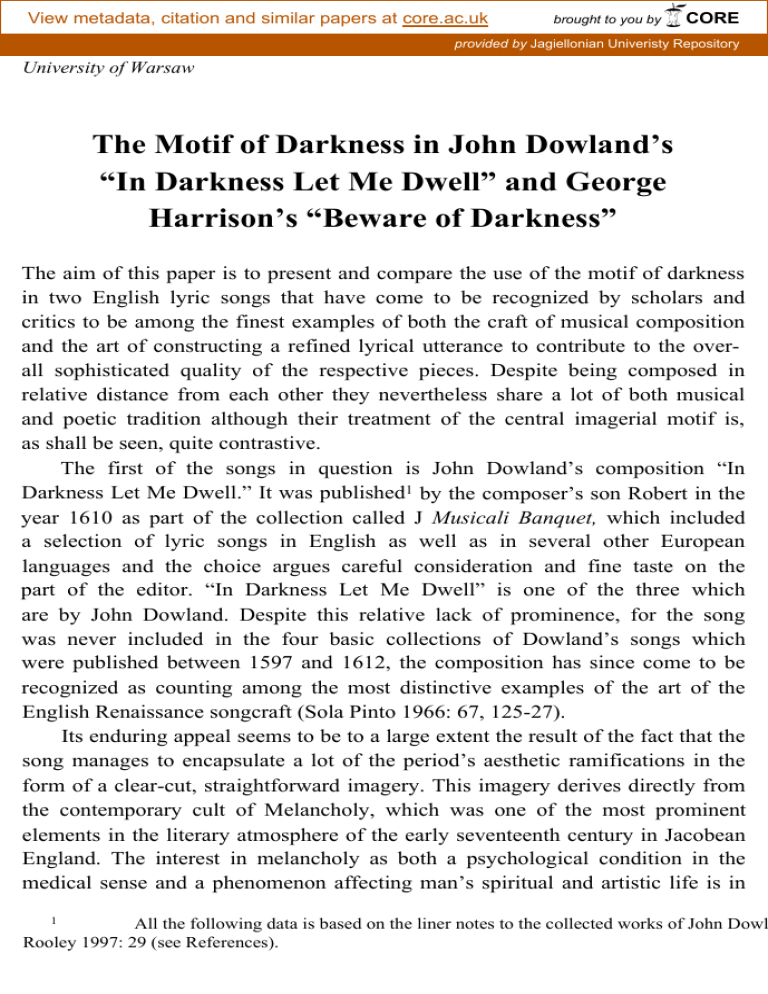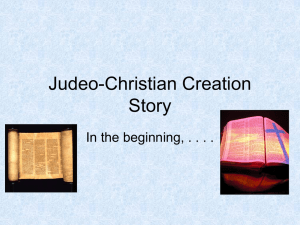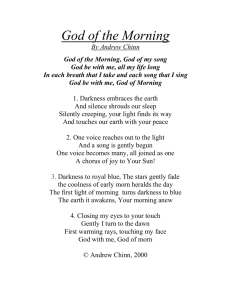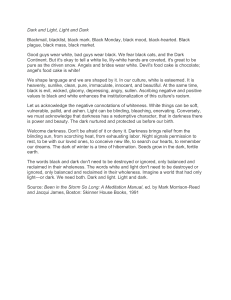
View metadata, citation and similar papers at core.ac.uk Bartłomiej Błaszkiewicz brought to you by CORE provided by Jagiellonian Univeristy Repository University of Warsaw The Motif of Darkness in John Dowland’s “In Darkness Let Me Dwell” and George Harrison’s “Beware of Darkness” The aim of this paper is to present and compare the use of the motif of darkness in two English lyric songs that have come to be recognized by scholars and critics to be among the finest examples of both the craft of musical composition and the art of constructing a refined lyrical utterance to contribute to the over­ all sophisticated quality of the respective pieces. Despite being composed in relative distance from each other they nevertheless share a lot of both musical and poetic tradition although their treatment of the central imagerial motif is, as shall be seen, quite contrastive. The first of the songs in question is John Dowland’s composition “In Darkness Let Me Dwell.” It was published1 by the composer’s son Robert in the year 1610 as part of the collection called J Musicali Banquet, which included a selection of lyric songs in English as well as in several other European languages and the choice argues careful consideration and fine taste on the part of the editor. “In Darkness Let Me Dwell” is one of the three which are by John Dowland. Despite this relative lack of prominence, for the song was never included in the four basic collections of Dowland’s songs which were published between 1597 and 1612, the composition has since come to be recognized as counting among the most distinctive examples of the art of the English Renaissance songcraft (Sola Pinto 1966: 67, 125-27). Its enduring appeal seems to be to a large extent the result of the fact that the song manages to encapsulate a lot of the period’s aesthetic ramifications in the form of a clear-cut, straightforward imagery. This imagery derives directly from the contemporary cult of Melancholy, which was one of the most prominent elements in the literary atmosphere of the early seventeenth century in Jacobean England. The interest in melancholy as both a psychological condition in the medical sense and a phenomenon affecting man’s spiritual and artistic life is in 1 All the following data is based on the liner notes to the collected works of John Dowl Rooley 1997: 29 (see References). 352 BARTŁOMIEJ BŁASZKIEWICZ itself a complex affair for it influenced, sometimes in a forceful, sometimes in a subtle way, virtually every aspect of the country’s cultural life. It thus extends from contemporary medical writings, through the music of Dowland and Byrd, the poetry of Donne and other metaphysical poets, the conservative “Golden Age” poetry of Samuel Daniel, Michael Drayton and George Chapman,2 to the character of Hamlet. The culmination of the fascination with Melancho­ lia was of course the well-known Anatomy of Melancholy by Robert Burton published in 1621, which in its way seeks to connect all the divergent strains of thought which had accumulated over the concept. Thus Burton develops the commonly shared idea which treats melancholy as an essentially mental condition originating from the excess of cold and dry quality in the balance of the four humours and resulting not only in languishing depression, but also in states of aimless agitation, restlessness and delusions. Quoting both European and Arab psychiatrists, Burton stresses the unique role of art and especially music and dancing in curing the condition.3 The understanding of this leads to a full appreciation of the nature of the link between melancholy and art. In this view, while the condition itself is not evidently positive, it potentially produces the right mental condition for the catharsis which art is in the natural position to offer. Thus music and poetry, which seem to obsessively concentrate on describing and defining the unwholesome mental state, offer by this very characteristic, an opportunity to undergo a process which in its essence is a therapeutic one. All this leads one to the theme of darkness which had come to be a central motif to convey the notion of Melancholia in poetic imagery among the artists and intellectuals connected to the person of Lucy Russell, the Countess of Bedford, who emerged at that time as the pivotal figure in the patronage of artists within the Pembroke/Essex baronial circle, supporting the likes of Daniel, Drayton, Dowland, and Donne. Of these it is perhaps John Donne’s literary output which was most intimately affected by the patronage and the friendship and this is evident in his verse epistles written to the Countess. Similarly, two most accomplished poems dealing with the melancholic state - “Twickenham Garden” and “A Noctural upon Saint Lucy’s Day” - were also composed by him. It is especially the latter which lays the blueprint for the use of the imagery of darkness for a poetic analysis of the melancholic mood. There the description of the melancholy endured on the year’s shortest day and caused by the death of 2 3 The term is used in the sense it has in Lewis 1968: 464-535. For more on the topic, see Radden 2002: 129-6. THE MOTIF OF DARKNESS ... 353 the beloved is conveyed through a series of images developing from the notion of darkness in the sense of privation, absence or “nothingness.” Although the contemplation of darkness here ends in despair, nonetheless it offers the purification necessary to experience the pain in the proper, conscious way which paradoxically will ultimately result in the obliteration of the pain itself: He ruin’d me, and I am re-begot Of absence, darkness, death - things which are not. What John Dowland does in his song is aiming at the same set of connotations via conventional allegory: In darkness let me dwell, The ground shall Sorrow be; The roof Despair to bar All cheerful light from me, The walls of marble black That moisten’d still shall weep; My music hellish jarring sounds To banish friendly sleep. Dowland’s song is not only simplified in metre (as one switches from the complex rhyme pattern of an iambic pentametre stanza in Donne to an abcb arrangement of iambic trimetre lines in Dowland), but in the whole poetic apparatus as well. Nevertheless its allegorical framework is effective enough to successfully convey the underlying poetic meaning. Thus in Dowland’s song darkness is the inside of a windowless house, where the conditions are defined by negative inference: there is no light there, no rest, no peace, and even time and space become obliterated. This is because with no light and the walls being made “of marble black” one cannot define physical dimensions. Furthermore the “jarring sounds” will not only induce extreme physical fatigue, which makes time orientation difficult, but will also prevent the speaker from conceiving of anything in terms of spatial orientation since the persistent existence of discord will make it impossible for proper music to enter the interior. Proper music, in contemporary understanding of the term, means sound which is arranged in time according to the notion of harmony, which, as all medieval and Renaissance psychology explained, is conceived of through an essentially spatial mental layout. Thus all possible mental sequencing of time is banished from the house of Melancholy with even the walls weeping incessantly so as to avoid being subject to any measurement. 354 BARTŁOMIEJ BŁASZKIEWICZ An interesting thing is that even the very structure of the house is designed to disorientate the inmate. This is because it seems that the natural allegorical design of the “ground” and the “roof’ is in fact inverted here and while the natural allegorical logic would possibly have made the roof out of sorrow and the ground - indicating the bottom-line - out of despair Dowland inverts the scheme and the purpose appears to be to even further alienate and disorientate the inhabitant of the house by altering even the most basic of all spatial landmarks - the up-and-down orientation points. Within such a framework darkness stands for the ultimate form of privation which is not only sensory and ultimately mental, but which is, as Donne more articulately puts it, “an elixir” of nothing, i.e. an emptiness arrived at through a condensation of ordinary emptiness, and hence one which is a more intense form of it. As such it combines the claustrophobic sense of the voluntary confinement with the sense of being lost in time and space. The voluntary nature of this confinement is, however, important here as the lyrical persona enters the house of Melancholy willingly and with no illusions as to its character: Thus wedded to my woes And bedded to my tomb, O let me living die, Till death do come. Thus the persona will “dwell” in the house - not properly speaking live, not wait and, significantly, not even exist. Just like in Donne’s lyric, being situated inside darkness means being situated inside nothing and it similarly aims at conveying the idea of a cathartic escape from the experienced pain paradoxically achieved by attuning all of one’s senses to the experience. The resulting state in which one will “living die” is in its essence a scheme which aims at transferring the experience out onto the surrounding. In this way dwelling in darkness is a way of preventing darkness from dwelling in you. This is because, although the reality of darkness is here all-encompassing and seemingly inescapable, it becomes dependent on the person of the observer as it is his conscious choice to be submerged in the trans-like state of contemplating the distillation of one’s own misfortune. Thus by projecting the tormenting experience onto the surrounding reality the persona himself becomes in a sense liberated from it as the contemplation of pain brings the fragmented perception back into focus and balance. THE MOTIF OF DARKNESS ... 355 Let us now turn to the second of the two lyrics with which our present argument is concerned. The song in question is George Harrison’s composition “Beware of Darkness,” which dates from 1970 when it constituted one of the many musical gems gracing the musician’s debut album All Things Must Pass originally a triple-vinyl collection which has since achieved the status of one of the very greatest artistic exercises in its musical genre.4 The two compositions offer possibilities of an interesting and revealing comparison by virtue of being closely approximate in formal characteristics and means of expression and most importantly, of course, by virtue of making the concept of darkness the cornerstone of their poetic imagery. The comparison is also interesting because the way in which George Harri­ son’s lyric develops this motif is quite divergent from the Renaissance composer. There are indeed two fundamental points of difference which account for the latter of the two lyrics using the concept of darkness in a distinctly different way. The first is that, with the cult of Melancholy being long confined to cultural history, “Beware of Darkness” substitutes for it a deeply spiritual, religious perspective which, although introduced into the lyric by subtle understatement, nevertheless permeates its entire imagery and message. The second point, which corresponds closely to the first, but this time relates directly to the form of the song, is that instead of an intimate lyric confession, as was the case in Dowland, Harrison’s song takes the form of an endearingly intimate address. Watch out now, Take care, beware of falling swingers Dropping all around you, The pain that often lingers in your fingertips Beware of darkness Although it is difficult to imagine leaving aside the autobiographical data concerning the composition of the song,5 no circumstantial context is able to account for the subtle turn of phrase which gives special forcefulness to the song’s unassuming utterances. The tone of the opening lines effortlessly devel­ ops the close relation between the speaker and the addressee and it automatically positions the lyric in the tradition of poems where the emotional closeness is a springboard for unpremeditated moral advice. In this context one cannot but 4 For the additional critical background, see Greene 2006: 139-84; Allison 2006: 110-15; Giuliano 1997: 85-158; for the biographical context, seeClayson 1997:220; Shapiro 2003:113-50. 5 The song was apparently conceived during the musician’s hospital visits to his mother dying of cancer. 356 BARTŁOMIEJ BŁASZKIEWICZ think of lyrics such as Chaucer’s “Truthe,” Kipling’s “If,” Dylan Thomas’s “Do Not Go Gentle Into that Good Night,” and Bob Dylan’s “Forever Young.” As one may expect, it is the poem by Dylan Thomas that corresponds most closely to Harrison’s lyric, although darkness is here not the blind massive force of unpremeditated annihilation depriving the dying of life and of pain in a way of natural kindness, just like it is not a soothing ingredient of a potentially therapeutic psychological exercise. Indeed, in stark contrast to Dowland, it is precisely dwelling in darkness which is to be avoided at all cost and, in stark contrast to Dylan Thomas, the idea of the inevitability of surrender is also to be strenuously resisted. This is because in Harrison’s song darkness is also a force of negation, but this time it is an active, powerful and vicious force pursuing the destruction of something which the song, in a masterful feat of well-pointed understatement, does not overtly name, but the loss of which seems to constitute the ultimate loss. One can immediately spot the heavily sinister undertone which accompanies the word “darkness” every time the speaker utters it. Thus, when, by contrast, in Dowland’s lyric the word is a descriptive term for the gloominess of mood accompanying Melancholy, in Harrison the word indicates a kind of intelligent black hole sucking in goodness in order to maintain and define its own exis­ tence. It is therefore a force much stronger than Dowland’s Melancholy, most importantly in the sense that it cannot be cheated to yield a therapeutic result not only because it seems to be in some way intelligent but because it is so thoroughly evil that no effort can produce any good result while partaking of its power. One may therefore ask for the reason why the word “darkness” closes each section of the speaker’s utterance since it is at the same time bestowed the insidiously sinister air. The reason seems to be that what darkness stands for in the lyric represents a force which irreparably destroys the very core of one’s being and is therefore harmful in an ultimate way, but which is for most of the time disguised as something else when it is actually encountered in everyday life. Hence the naming of “darkness,” in the hushed, almost reverent way in which the celebratory tone is contrived to allay the naked primitive terror which the word conjures up, is designed to serve as a way to emphasize the need to at all cost defend oneself, or someone dear and precious, against what the word represents and in order to do this one has to identify “darkness” behind the veil of everyday reality. The risk inherent in the repeated mention of the dreaded word is apparently worth taking because to fall for “darkness” would be worse than the worst fear of what the word itself portends. THE MOTIF OF DARKNESS ... 357 Thus “darkness” seems to lurk here inside various things - it is equally present in the false promise inherent in the life of the “swingers,” or social climbers of a robustly egotistic persuasion, and in the lives they change by the way they live theirs, as well as in the lives of those for whom the emotional burden of a deeply experienced personal loss makes it impossible to regain mental equilibrium (and it is here worth noting how superbly effective the line about the “pain which lingers in your fingertips” is in imaginatively evoking the depth of the feeling). One may easily notice that, despite the two walks of life being mutually exclusive in a very firm way, the danger of “darkness” is part of both experiences. The second stanza of the song develops the idea further by adding another possibility, this time it is the entanglement in the endless maze of one’s own private mind, stemming, as it often may, from the observation of all the negative aspects of the outside world: Watch out now, Take care, beware the thoughts that linger Winding up inside your head The hopelessness around you In the dead of night Beware of sadness The next section of the lyric brings in more of the spiritual dimension, which also positions the song in contrast with “In Darkness Let Me Dwell.” While in Dowland’s song the mental pain was considered the ultimate threat, in Harrison’s song what is thought of as a greater danger is the fact that the pain involved in the contact with “darkness” diverts one from the destined course of one’s life. Thus the purpose of life is not, as in Dowland, personal gratification, but it appears to function as part of a greater design which transcends the indi­ vidual mind - in other words one does not live in order to be happy but to fulfil a mission for which one is placed in life by a force beyond one’s own volition: It can hit you, it can hurt you Make you sore and what is more That is not what you are here for. The last section of the song begins with a juxtaposition of a crowd of dancers made up of those whose have chosen not to answer to the destiny bestowed on them, and the solitary “unconscious sufferer” who, while he may or may not be part of the dancing crowd (notice the understatement again), 358 BARTŁOMIEJ BŁASZKIEWICZ is not able to discover his mission in life because, in some similarity to the speaker in Dowland, he cannot isolate and focus on the precise nature of his pain. However, it is also here that Dowland and Harrison part company. This is because, while in Dowland’s song the liberation is achieved through a manipulation of reality, Harrison invokes Maya - the deity which in the Indian religions is responsible for creating all manner of illusions and false appearances, and which, specifically in Hinduism, needs to be overcome in order to achieve the true vision of the divine essence:6 Watch now, take care Beware of soft shoe shufflers Dancing down the sidewalks, As each unconscious sufferer Wanders aimlessly, Beware of MAYA Watch now take care, Beware of greedy leaders They’ll take you where you should not go, While Weeping Atlas Cedars They just want to grow Beware of darkness. Now it is important to realize that, although the stylistic use of the concept is similar, Maya is not strictly speaking the “darkness” which has been defined as the ultimate threat of spiritual existence. It is more that the danger of not seeing through the appearances of life is that Maya may prevent one from identifying some strands of human experience as leading not just to pain and sadness, but, more crucially, into “darkness.” Hence all the illusions of life are, as it were, the tool of “darkness” used to waylay the unwary into a trap. Indeed the idea of the dangers of life stealthily sucking in one not on his proper guard is restated once again in the last lines of the song and it is also here that the religious perspective reasserts itself again in the careful phrasing chosen for the closing verses. The danger represented by the “greedy leaders” consists in drawing one into compromising what may be called the pure form of life and substituting it for ideologies imitating the true values of life by offering life-defining philosophies which are, however, based on the greed and ambition of some and the denial of the fullness of existence for many. 6 See Eliade 1994b: 129-37; Eliade 1994a: 33-51. THE MOTIF OF DARKNESS ... 359 Here the notion of the inherent nature of life as a mission returns in the line warning that shallow ideologies is where “you should not go” not because of an arbitrary prohibition (and therefore not “where you mustn’t go”) but because to live one’s life to the full is to live it according to the way it was objectively designed to be lived. Therefore, just like the Atlas Cedars fulfill their vocation by living to the full their natural mission to grow (which, importantly, is not the same as having the opportunity to grow to the full) the human life is also thought of here a mission to achieve the fullness of life (and the careful use of understatement is also worth noting here), while “darkness” is a force which seeks to make one accept pain, frustration and the sense of loss as the ultimate reality. Hence the reason why in George Harrison’s song the illusion inherent in darkness cannot be put to a good use is that the imagery of the song builds on reference to an objective reality which is independent of the mental reality of the speaker, and the illusion of the reality of pain is also in its roots conditioned from the outside even if it works solely within the realm of individual psychology. As may be now observed, the understanding of the concept of darkness and its role in the imagery of the two respective pieces is markedly different, but in either case it is developed with a commendable poetic precision where the craft of the word goes side by side with the musical accomplishment and thus it is to be hoped that the comparative study of the two songs has revealed the potential of this form of artistic expression for putting forward lyric arguments of considerable sophistication and intellectual depth. Thus the juxtaposition of the two lyrics undertaken here has been designed to display some of the semantic possibilities exploited by those searching for a more profound meaning behind concepts and ideas current in their time. This search frequently yields rich and multifarious, though incompatible, results whereby the interplay of contradictory meanings may invest notions like that of darkness with the subtle form of ambiguity inherent in concepts the con­ templation of which has, over the ages, proved both puzzling and invigorating to generations of artists. 360 BARTŁOMIEJ BŁASZKIEWICZ REFERENCES Allison, D. C. 2006. The Love There That's Sleeping: The Art and Spirituality of George Harrison. London & New York: Continuum. Dowland, J. 1997. The Collected Works. London: Editions de L’Oiseau-Lyre/Decca Records Company. Clayson, A. 1997. The Quiet One: A Life of George Harrison. London: Sanctuary Publishing. Eliade, M. 1994a. Historia wierzeń i idei religijnych. Vol. 2. Warszawa: Instytut Wydawniczy PAX. Eliade, M. 1994b. Słownik religii. Warszawa: Oficyna Wydawnicza Volumen. Giuliano, G. 1997. The Life and Art of George Harrison. London: Da Capo Press. Greene, J. M. 2006. Here Comes the Sun: Spiritual and Musical Journey of George Harrison. London & New York: Continuum. Harrison, G. 2001. All Things Must Pass. London, England. EMI Records. Jakimowicz-Shah, M. and A. Jakimowicz. 1982. Mitologia indyjska. Warszawa: Wy­ dawnictwa Artystyczne i Filmowe. Lewis, C. S. 1968. English Literature in the Sixteenth Century Excluding Drama. Oxford: Clarendon Press. Radden, J., ed. 2002. The Nature of Melancholy. New York: Oxford University Press. Rooley, A. 1997. Liner notes to John Dowland. The Collected Works. London: Editions de L’Oiseau-Lyre/Decca Records Company. Shapiro, M. 2003. Behind Sad Eyes: The Life of George Harrison. London: St. Martin’s Griffin. Sola Pinto de, V. 1966. The English Renaissance 1510-1688. London: The Cresset Press.


